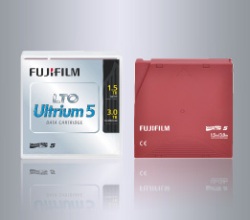Mar 20 2010
FUJIFILM Recording Media U.S.A., Inc., a division of Fujifilm Corporation the leading global manufacturer of data storage media1, today announced it will be one of the first manufacturers in the world to be certified by the Linear Tape-Open (LTO) Technology Provider Companies (TPCs) as successfully completing compliance testing.
 LTO Ultrium Data Cartridge
LTO Ultrium Data Cartridge
Fujifilm plans to immediately begin mass production of LTO Ultrium Generation 5 data cartridges. The Fujifilm LTO Ultrium Generation 5 cartridges are available worldwide immediately, and offer a native storage capacity of 1.5 terabytes and native transfer rates up to 140 megabytes per second.
“The advances that Fujifilm has made in its proprietary NANOCUBIC technology have enabled us to achieve a higher recording density with increased reliability,” said Norio Shibata, President & CEO, Fujifilm Recording Media USA, Inc. “As the need for more capacity continues to steadily increase this latest generation tape will handle more data while simultaneously reducing the risk of loss of information.”
Fujifilm LTO Ultrium Generation 5 data cartridges will incorporate Fujifilm’s advanced NANOCUBIC thin-film coating process with finer metal particles (78% of previous generation Ultrium data cartridges) and nano-dispersion technology with a new binder system, which allows Fujifilm to achieve higher recording density.
“The advances that we have made to our technology will go a long way toward meeting the rapidly increasing demands that our customers have for long term file storage and data management,” said Peter Faulhaber, Senior Vice President Sales & Marketing, FUJIFILM Recording Media U.S.A., Inc. “The escalating volume of data coupled with the rising concerns over security and need for rapid retrieval lead us to believe that this next generation technology will be very well received in the marketplace.”
In addition, Fujifilm has introduced a new reel design that has successfully achieved both running stability in the drive and high archival stability. This is a feature that is particularly important for users because as the tape length gets longer, the pressure on the hub can increase and there is a potential risk of hub deformation. The new design of the hub structure reduces unexpected deformation to the tape’s characteristics, such as tape edge damage while the smoother, more uniform magnetic layer results in a significant decrease in tape surface defects.
As part of Fujifilm’s overall commitment to develop environmentally sustainable products, Fujifilm’s LTO Ultrium 5 cartridge offers a reduction on its impact on the environment by eliminating brominated flame retardants (BFRs) from all the mechanical parts of Fujifilm LTO 5 cartridges. Tape is already viewed by many in the data storage industry to have less of an impact on the environment than other storage options because it consumes less energy.
LTO technology is a powerful, scalable, adaptable open tape format developed and enhanced by TPCs: HP, IBM and Quantum to help address the growing demands of data protection in the midrange to enterprise-class server environments.
“LTO Ultrium Generation 5 introduces a new dual partitioning functionality. This feature can enable capabilities to enhance file management on LTO tape and unlock LTO tape's potential for exciting new use cases for the growing storage needs of market segments with rich media such as media and entertainment, digital surveillance, and medical,” said Ed Childers, Manager, Tape Development, IBM.
LTO Generation 5 hardware will be backward write compatible with LTO Ultrium 4 data cartridges and backward read compatible with LTO Ultrium 3 data cartridges. As with the previous generation, LTO Ultrium 5 hardware will incorporate the Advanced Encryption Standard (AES) 256-bit encryption algorithms to help keep data secure. This feature offers another level of security during storage and transporting of sensitive information and compliments the WORM (Write-Once, Read-Many) capability. WORM functionality first debuted in LTO Ultrium 3 data cartridges, providing a cost-effective means for storing data in a non-rewriteable format to help address compliance requirements.
The TPCs provide very stringent format specifications for both cartridge and drive manufacturers. This helps insure the consistency for maintaining tape format interchangeability. Compliance testing is completed through a unique format verification program which is independently administered and executed by a third party organization, and approved by the TPCs.
Source: http://www.fujifilmusa.com/